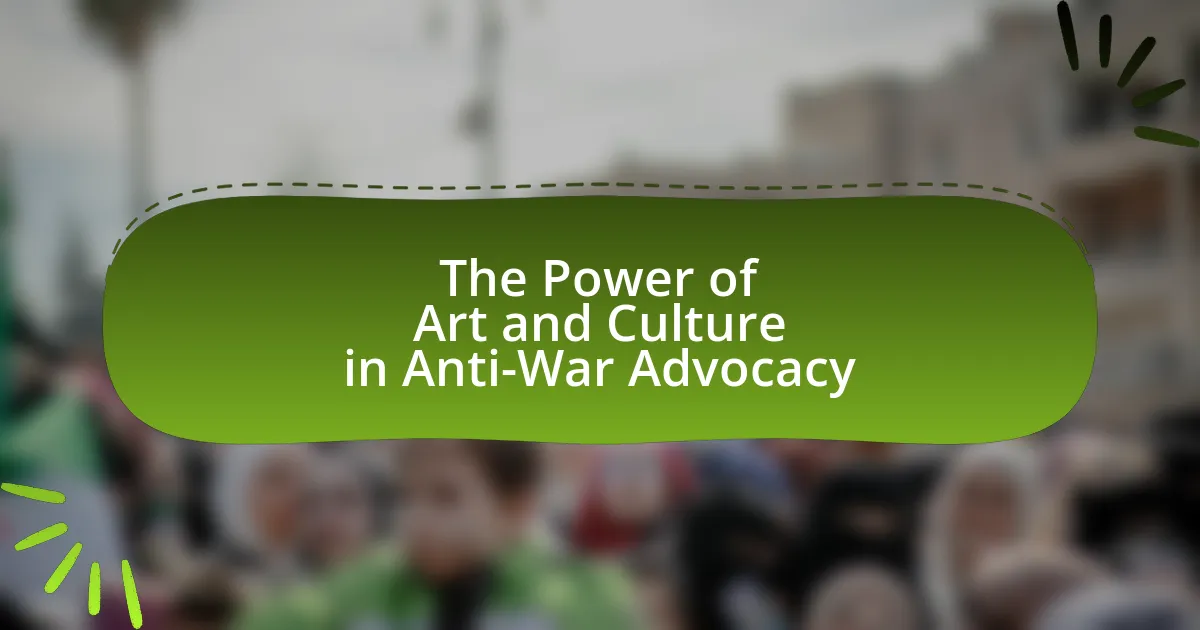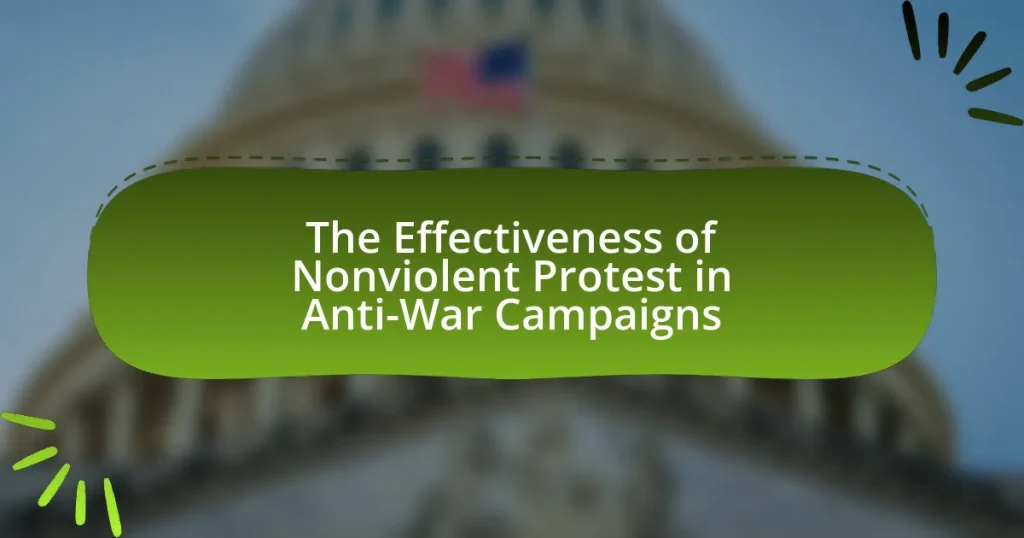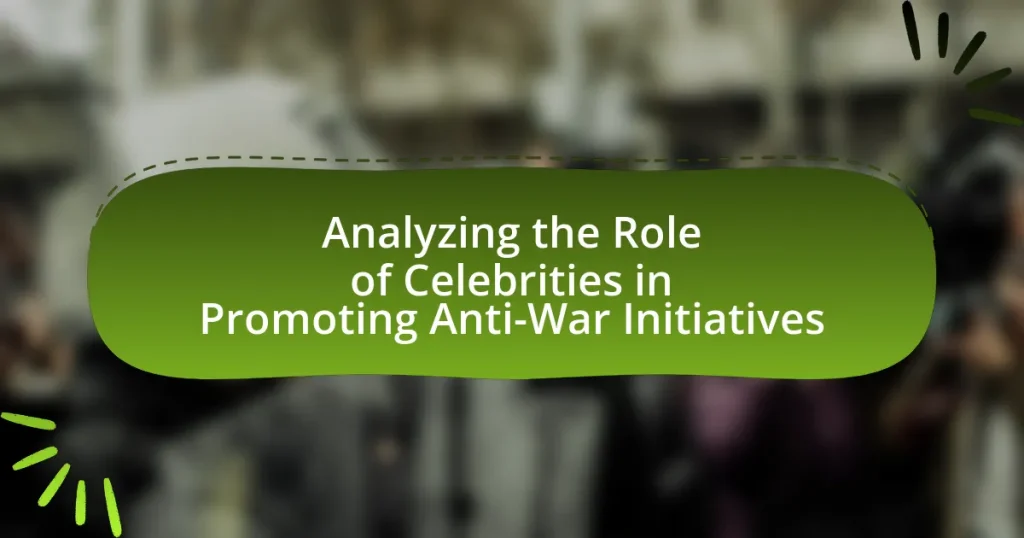The article examines the significant role of art and culture in anti-war advocacy, highlighting how various artistic mediums—such as visual arts, literature, music, and performance—effectively convey anti-war messages and foster emotional connections. It discusses historical examples, including Picasso’s “Guernica” and protest songs from the Vietnam War era, illustrating how these expressions shape public perception and mobilize collective action against militarism. Additionally, the article addresses the challenges artists face, such as censorship and funding limitations, while exploring strategies for overcoming these obstacles through collaboration and community engagement. Ultimately, it emphasizes the importance of cultural expressions in influencing societal attitudes toward war and promoting peace.
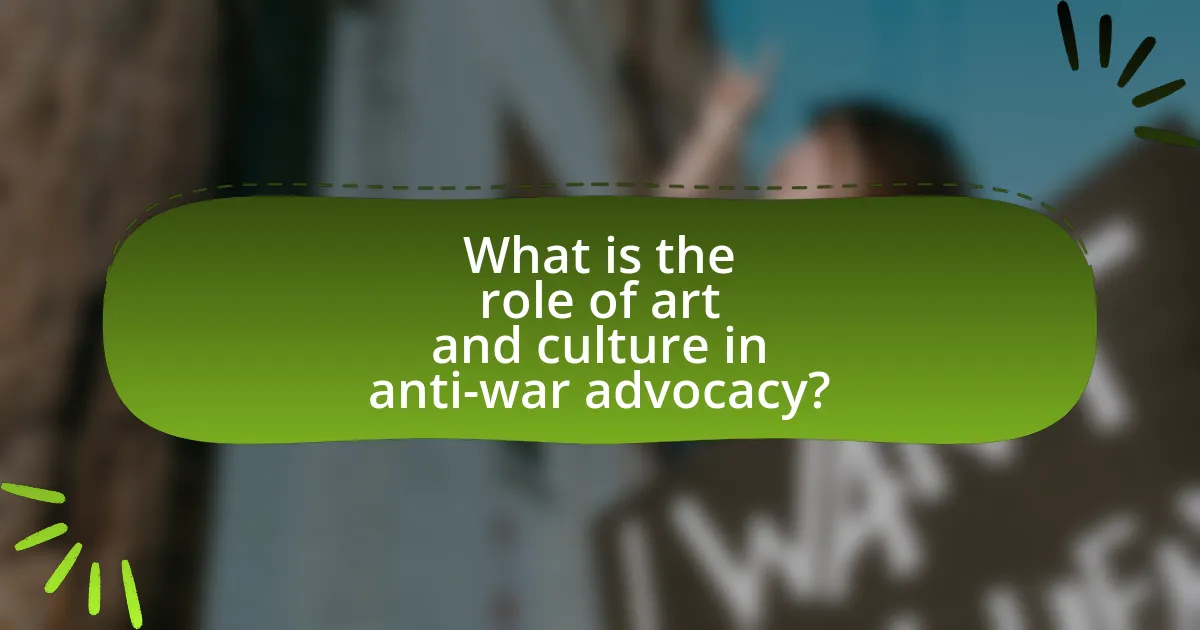
What is the role of art and culture in anti-war advocacy?
Art and culture play a crucial role in anti-war advocacy by fostering emotional connections and raising awareness about the consequences of conflict. Through various mediums such as literature, visual arts, music, and performance, artists convey powerful messages that challenge militarism and promote peace. Historical examples include Pablo Picasso’s “Guernica,” which depicts the horrors of war and has become a symbol of anti-war sentiment, and the protest songs of the 1960s, which galvanized public opposition to the Vietnam War. These artistic expressions not only engage audiences but also inspire collective action, making art a vital tool in the fight against war.
How does art influence public perception of war?
Art significantly influences public perception of war by shaping narratives and evoking emotional responses. Through various mediums such as paintings, literature, music, and film, artists can highlight the human cost of conflict, challenge glorified depictions of war, and foster empathy for those affected. For instance, Picasso’s “Guernica” powerfully depicts the horrors of the Spanish Civil War, impacting public sentiment and awareness about the brutality of war. Additionally, anti-war songs from the 1960s, like Bob Dylan’s “Blowin’ in the Wind,” galvanized public opposition to the Vietnam War by questioning the morality of military actions. These artistic expressions serve as critical tools for advocacy, influencing societal attitudes and encouraging discourse around the consequences of war.
What types of art are most effective in conveying anti-war messages?
Visual art, literature, and performance art are the most effective types of art in conveying anti-war messages. Visual art, such as paintings and sculptures, can evoke strong emotional responses and provoke thought, as seen in works like Pablo Picasso’s “Guernica,” which powerfully depicts the horrors of war. Literature, including poetry and novels, allows for deep exploration of the human experience during conflict, exemplified by Erich Maria Remarque’s “All Quiet on the Western Front,” which critiques the romanticism of war. Performance art, including theater and music, can engage audiences in real-time, creating a visceral connection to anti-war sentiments, as demonstrated by productions like “The Vagina Monologues,” which address the impact of war on women. These art forms effectively communicate the devastating consequences of war, fostering empathy and encouraging social change.
How do cultural expressions shape narratives around conflict?
Cultural expressions shape narratives around conflict by influencing perceptions, emotions, and understandings of the issues involved. Art, literature, music, and performance can humanize the experiences of those affected by conflict, fostering empathy and awareness. For instance, the anti-war movement during the Vietnam War utilized songs like “Fortunate Son” by Creedence Clearwater Revival to critique social injustices and mobilize public sentiment against the war. This demonstrates how cultural expressions can challenge dominant narratives and promote alternative viewpoints, ultimately impacting public opinion and policy.
Why is culture a powerful tool in anti-war movements?
Culture is a powerful tool in anti-war movements because it shapes public perception and fosters emotional connections that can mobilize individuals against conflict. Through various forms of expression such as music, literature, and visual arts, cultural narratives can challenge dominant war ideologies and highlight the human cost of violence. For instance, the anti-war protests during the Vietnam War were significantly influenced by songs like “Fortunate Son” by Creedence Clearwater Revival, which resonated with the youth and critiqued the inequities of conscription. Additionally, art installations and films can evoke empathy and provoke critical discussions about the consequences of war, making abstract concepts more relatable and urgent. This cultural engagement not only raises awareness but also builds solidarity among diverse groups, amplifying the anti-war message and encouraging collective action.
What historical examples illustrate the impact of culture on anti-war sentiments?
Historical examples that illustrate the impact of culture on anti-war sentiments include the Vietnam War protests in the 1960s and 1970s, where music, literature, and visual arts played significant roles in shaping public opinion against the war. The song “Fortunate Son” by Creedence Clearwater Revival became an anthem for the anti-war movement, highlighting class disparities in military service. Additionally, the publication of works like “Slaughterhouse-Five” by Kurt Vonnegut and the widespread distribution of anti-war posters and art contributed to a cultural climate that fostered dissent. These cultural expressions galvanized public sentiment, leading to mass protests and a shift in national attitudes toward the war, ultimately influencing policy decisions.
How do cultural events foster community engagement in anti-war advocacy?
Cultural events foster community engagement in anti-war advocacy by creating shared spaces for dialogue, expression, and solidarity among participants. These events, such as art exhibitions, music festivals, and theater performances, serve as platforms for individuals to voice their opposition to war and promote peace. For instance, the “Art for Peace” initiative has successfully brought together diverse communities to collaborate on projects that highlight the human costs of conflict, thereby increasing awareness and mobilizing action. Research indicates that participation in cultural activities enhances social cohesion and encourages collective action, making it a vital component of effective anti-war movements.

How do different art forms contribute to anti-war advocacy?
Different art forms contribute to anti-war advocacy by effectively conveying emotional messages, raising awareness, and fostering community engagement. Visual arts, such as paintings and installations, can depict the horrors of war, influencing public perception and prompting critical discussions; for example, Pablo Picasso’s “Guernica” powerfully illustrates the devastation of war and has become a symbol of anti-war sentiment. Literature, including poetry and novels, often explores the human cost of conflict, as seen in works like Erich Maria Remarque’s “All Quiet on the Western Front,” which highlights the psychological impact of war on soldiers. Music also plays a significant role, with protest songs like Bob Dylan’s “Blowin’ in the Wind” galvanizing movements and inspiring collective action against war. These art forms not only communicate the anti-war message but also mobilize individuals and communities to advocate for peace, demonstrating the profound impact of art in shaping societal attitudes toward conflict.
What role does visual art play in anti-war campaigns?
Visual art serves as a powerful tool in anti-war campaigns by conveying emotional messages that resonate with the public and provoke critical thought about the consequences of war. Through imagery, artists can illustrate the human suffering caused by conflict, making abstract concepts tangible and relatable. For instance, works like Picasso’s “Guernica” depict the horrors of war and have historically galvanized public sentiment against violence, influencing political discourse. Additionally, visual art can foster community engagement and solidarity among activists, as seen in various protest posters and murals that unify messages against militarism. This capacity to evoke empathy and inspire action underscores the significant role visual art plays in shaping anti-war narratives and mobilizing social movements.
How do murals and installations communicate anti-war messages?
Murals and installations communicate anti-war messages by visually depicting the consequences of conflict and promoting peace through powerful imagery and symbolism. These artistic expressions often portray the suffering of civilians, the destruction of communities, and the futility of war, thereby evoking emotional responses that challenge viewers’ perceptions of violence. For example, the mural “Guernica” by Pablo Picasso illustrates the horrors of war and has become a universal symbol of anti-war sentiment. Additionally, installations like “The Fallen” by artist David McCullough, which features thousands of shoes representing lives lost in conflict, serve as poignant reminders of the human cost of war. Such artworks engage the public, provoke dialogue, and inspire activism against militarism, effectively using art as a medium for social change.
What impact do photography and film have on public awareness of war issues?
Photography and film significantly enhance public awareness of war issues by visually documenting the realities of conflict, thereby evoking emotional responses and fostering empathy. For instance, iconic images such as the “Napalm Girl” photograph from the Vietnam War and films like “Saving Private Ryan” have profoundly influenced public perception and discourse surrounding warfare. Research indicates that visual media can increase engagement and understanding of complex issues, as evidenced by a study published in the Journal of Peace Research, which found that exposure to war-related imagery can lead to greater public advocacy for peace initiatives. Thus, photography and film serve as powerful tools in shaping societal attitudes towards war and its consequences.
How does music serve as a medium for anti-war expression?
Music serves as a powerful medium for anti-war expression by conveying emotional messages that resonate with audiences and inspire social change. Through lyrics, melodies, and performances, artists articulate the horrors of war, promote peace, and foster solidarity among listeners. Historical examples include songs like “Give Peace a Chance” by John Lennon, which became an anthem for the anti-Vietnam War movement, and “Fortunate Son” by Creedence Clearwater Revival, which criticized the inequities of conscription during the same era. These songs not only reflect public sentiment but also mobilize individuals to engage in activism, demonstrating music’s role in shaping cultural narratives against war.
What are some iconic anti-war songs and their messages?
Some iconic anti-war songs include “Fortunate Son” by Creedence Clearwater Revival, “Give Peace a Chance” by John Lennon, and “War” by Edwin Starr. “Fortunate Son” critiques the privilege of those who evade the draft, highlighting class disparities in wartime. “Give Peace a Chance” promotes peace and unity, becoming an anthem for the anti-Vietnam War movement. “War” explicitly states that “war is not the answer,” emphasizing the futility and destructiveness of conflict. These songs effectively convey powerful messages against war, resonating with audiences and influencing public sentiment.
How do music festivals promote anti-war activism?
Music festivals promote anti-war activism by providing a platform for artists and activists to express anti-war messages through music and performances. These events often feature songs and speeches that highlight the consequences of war, fostering a sense of community and shared values among attendees. For instance, festivals like Woodstock in 1969 became iconic for their anti-war sentiments, with performances that directly addressed the Vietnam War. Additionally, many festivals collaborate with organizations that advocate for peace, using their reach to raise awareness and funds for anti-war initiatives. This combination of artistic expression and activism effectively mobilizes audiences, encouraging them to engage in political discourse and action against war.
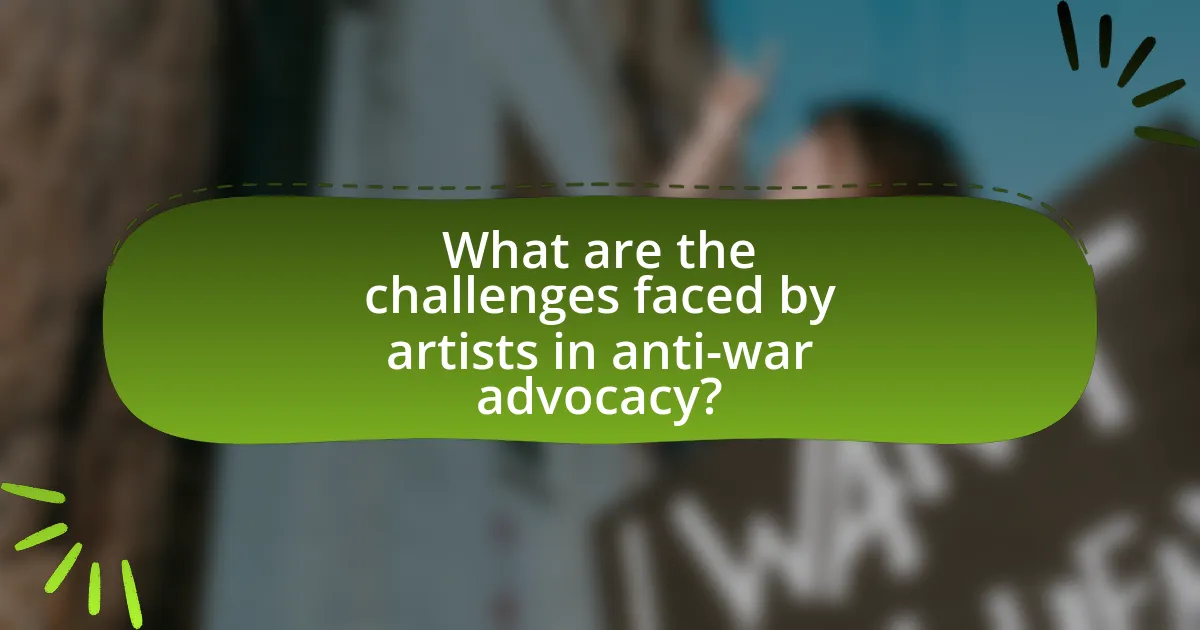
What are the challenges faced by artists in anti-war advocacy?
Artists in anti-war advocacy face significant challenges, including censorship, public backlash, and funding limitations. Censorship often arises from governmental or institutional pressures that seek to suppress dissenting voices, limiting artists’ ability to express their views freely. Public backlash can manifest as negative reactions from audiences or communities that may not support anti-war sentiments, leading to social isolation or professional repercussions for the artists involved. Additionally, funding limitations hinder artists’ capacity to produce and promote their work, as financial support may be difficult to secure for projects that challenge prevailing narratives about war. These challenges collectively impede the effectiveness of artistic expression in advocating for peace.
How do political climates affect artistic expression in anti-war contexts?
Political climates significantly influence artistic expression in anti-war contexts by shaping the themes, mediums, and reception of artistic works. In repressive political environments, artists often face censorship, which can lead to the use of metaphor and symbolism to convey anti-war messages indirectly, as seen in the works of artists like Pablo Picasso during the Spanish Civil War. Conversely, in more open political climates, artists may freely express their dissent, leading to a proliferation of direct critiques of war, as evidenced by the anti-war movements during the Vietnam War, where music, literature, and visual arts flourished. Historical examples, such as the protest songs of Bob Dylan and the visual art of the Guerrilla Girls, illustrate how political freedom allows for more explicit and varied forms of artistic expression against war.
What risks do artists face when creating anti-war works?
Artists face significant risks when creating anti-war works, including censorship, legal repercussions, and personal safety threats. Censorship can occur when governments or institutions suppress artistic expression that challenges prevailing narratives, as seen in countries with authoritarian regimes where dissenting voices are silenced. Legal repercussions may involve charges of sedition or incitement, which have historically been used to prosecute artists, such as during the McCarthy era in the United States. Additionally, artists may face threats to their personal safety, including harassment or violence, particularly in conflict zones or politically unstable regions, where their works may provoke backlash from both state and non-state actors. These risks highlight the precarious position of artists who engage in anti-war advocacy through their creative expressions.
How can censorship impact the effectiveness of anti-war art?
Censorship can significantly diminish the effectiveness of anti-war art by restricting the expression of critical viewpoints and limiting the dissemination of powerful messages. When governments or institutions impose censorship, they often silence artists who challenge prevailing narratives about war, thereby reducing public awareness and engagement with anti-war sentiments. For instance, during the Vietnam War, many anti-war artists faced censorship, which hindered their ability to communicate the harsh realities of conflict and its consequences. This suppression not only stifles creativity but also prevents the broader society from confronting uncomfortable truths, ultimately weakening the impact of anti-war art as a tool for advocacy and social change.
What strategies can artists use to overcome these challenges?
Artists can use collaboration, community engagement, and digital platforms to overcome challenges in anti-war advocacy. Collaboration with other artists and organizations can amplify their message and create a stronger impact. Community engagement allows artists to connect with audiences on a personal level, fostering empathy and understanding. Utilizing digital platforms enables artists to reach a wider audience, share their work, and mobilize support for anti-war initiatives. For instance, social media campaigns have successfully raised awareness and funds for various causes, demonstrating the effectiveness of these strategies in promoting peace and solidarity.
How can collaboration enhance the impact of anti-war art initiatives?
Collaboration can enhance the impact of anti-war art initiatives by pooling diverse perspectives and resources, which amplifies the message and reach of the artwork. When artists, activists, and communities work together, they create a multifaceted narrative that resonates more deeply with audiences. For instance, collaborative projects like the “Art for Peace” initiative have successfully united various artists to produce works that address the consequences of war, thereby increasing public engagement and awareness. This collective effort not only broadens the artistic expression but also fosters a sense of solidarity among participants, making the anti-war message more compelling and influential.
What role do social media and digital platforms play in promoting anti-war art?
Social media and digital platforms serve as crucial tools for promoting anti-war art by providing widespread accessibility and facilitating rapid dissemination of artistic expressions. These platforms enable artists to share their work with a global audience, bypassing traditional gatekeepers such as galleries and museums. For instance, campaigns like #ArtForPeace on Instagram have successfully mobilized artists and activists to create and share anti-war messages, reaching millions in a matter of hours. Additionally, digital platforms allow for interactive engagement, where audiences can participate in discussions, share their interpretations, and amplify the messages of anti-war art, thereby fostering a community of support and activism. The ability to share multimedia content, such as videos and images, enhances the emotional impact of anti-war art, making it more relatable and compelling to viewers.
What practical steps can individuals take to support anti-war art and culture?
Individuals can support anti-war art and culture by actively engaging with and promoting works that convey anti-war messages. This can be achieved through attending exhibitions, performances, and screenings that focus on anti-war themes, thereby increasing visibility and appreciation for such art. Additionally, individuals can share anti-war art on social media platforms, amplifying the reach of these messages to a broader audience. Supporting artists financially through purchasing their work or donating to organizations that promote anti-war art can also provide essential resources for continued creation. Furthermore, participating in community events or workshops that foster discussions around anti-war sentiments can help cultivate a supportive environment for this type of art. These actions collectively contribute to a cultural landscape that values and prioritizes anti-war expressions.
How can community members engage with local anti-war art initiatives?
Community members can engage with local anti-war art initiatives by participating in workshops, attending exhibitions, and collaborating with artists to create impactful works. These initiatives often seek public involvement to amplify their messages, and community members can contribute by sharing their perspectives and experiences related to war and peace. For instance, local art collectives frequently host events that invite residents to express their views through various art forms, fostering a collective dialogue against war. Engaging in these activities not only supports the artists but also strengthens community bonds and raises awareness about the consequences of conflict.
What resources are available for those interested in promoting anti-war advocacy through art?
Resources available for promoting anti-war advocacy through art include organizations like Artists Against War, which provides platforms for artists to collaborate and showcase anti-war messages. Additionally, the Creative Coalition offers grants and support for projects that align with social justice themes, including anti-war initiatives. Art for Peace is another resource that connects artists with campaigns aimed at promoting peace and opposing militarism. These organizations often host exhibitions, workshops, and events that facilitate artistic expression focused on anti-war sentiments, thereby fostering community engagement and awareness.
